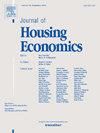Upzoning and redevelopment: The details matter
IF 2.4
3区 经济学
Q3 ECONOMICS
引用次数: 0
Abstract
Facing worsening housing affordability, policymakers in a growing number of jurisdictions have heeded economists’ calls for increases in supply through relaxing land use restrictions, particularly on maximum allowed density and increases in the number of units allowed on a single lot. While floor space or floor area ratios (FSR or FAR) and unit count per lot are indicators of the potential for density, local governments have many levers to control the volume, type, and pace of new construction. In this paper, we compare changes in land prices and the pace of redevelopment following two similar, moderate density upzonings (up to four units per lot) of single family neighborhoods in the province of British Columbia (Canada). The upzoning in the City of Kelowna resulted in considerable new construction of higher density residential units as well as a significant increase in lot prices in the upzoned area relative to nearby areas with status quo zoning. In contrast, though the changes in allowed density were nearly identical, in Coquitlam there has been minimal uptake of new multiplex options and no discernible land lift in response to upzoning. We highlight the importance of other regulatory levers that are easy for analysts to miss in contributing to these different outcomes. The Kelowna upzoning was matched with an expedited development permit process for as-of-right fourplexes. In contrast, the Coquitlam rezoning did not alter the city’s lengthy development permit process required to build beyond the baseline duplex. Kelowna’s upzoning also required less parking than Coquitlam’s. An assessment of the regulatory environment relying on the presence of the upzoning alone would miss the alteration to process (or absence thereof) that appear to have had a significant effect across the two municipalities in whether zoning changes led to actual new construction.
升级和重建:细节很重要
面对日益恶化的住房负担能力,越来越多的司法管辖区的政策制定者听从了经济学家的呼吁,通过放松土地使用限制来增加供应,尤其是在最大允许密度和增加单块土地上允许的单位数量方面。虽然建筑面积或容积率(FSR或FAR)和每一块土地的单位数是潜在密度的指标,但地方政府有很多手段来控制新建筑的数量、类型和速度。在本文中,我们比较了不列颠哥伦比亚省(加拿大)的两个类似的中等密度的单户社区的土地价格变化和重建速度,每地块最多四个单元。基洛纳市的分区升级导致了大量高密度住宅单元的新建设,并且与现有分区的附近地区相比,分区升级地区的地段价格大幅上涨。相比之下,虽然允许密度的变化几乎相同,但在高贵林,很少采用新的多厅选择,也没有明显的土地抬升来应对分区升级。我们强调了其他监管杠杆的重要性,这些杠杆在促成这些不同结果方面很容易被分析师忽视。基洛纳的分区升级与加速开发许可程序相匹配,以获得四层住宅的权利。相比之下,高贵林的重新规划并没有改变该市冗长的开发许可程序,该程序要求在基线复式公寓之外进行建设。与高贵林相比,基洛纳的升级区需要的停车位也更少。对监管环境的评估只依赖于分区升级的存在,会忽略流程的改变(或不改变),这似乎对两个城市的分区变化是否导致实际的新建筑产生了重大影响。
本文章由计算机程序翻译,如有差异,请以英文原文为准。
求助全文
约1分钟内获得全文
求助全文
来源期刊

Journal of Housing Economics
Multiple-
CiteScore
3.30
自引率
4.20%
发文量
35
期刊介绍:
The Journal of Housing Economics provides a focal point for the publication of economic research related to housing and encourages papers that bring to bear careful analytical technique on important housing-related questions. The journal covers the broad spectrum of topics and approaches that constitute housing economics, including analysis of important public policy issues.
 求助内容:
求助内容: 应助结果提醒方式:
应助结果提醒方式:


